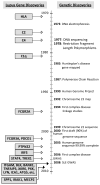Recent insights into the genetic basis of systemic lupus erythematosus
- PMID: 19440199
- PMCID: PMC3144759
- DOI: 10.1038/gene.2009.39
Recent insights into the genetic basis of systemic lupus erythematosus
Abstract
Genetic variation was first shown to be important in systemic lupus erythematosus (SLE or lupus) in the 1970s with associations in the human leukocyte antigen region. Almost four decades later, and with the help of increasingly powerful genetic approaches, more than 25 genes are now known to contribute to the mechanisms that predispose individuals to lupus. Over half of these loci have been discovered in the past 2 years, underscoring the extraordinary success of genome-wide association approaches in SLE. Well-established risk factors include alleles in the major histocompatibility complex region (multiple genes), IRF5, ITGAM, STAT4, BLK, BANK1, PDCD1, PTPN22, TNFSF4, TNFAIP3, SPP1, some of the Fcgamma receptors, and deficiencies in several complement components, including C1q, C4 and C2. As reviewed here, many susceptibility genes fall into key pathways that are consistent with previous studies implicating immune complexes, host immune signal transduction and interferon pathways in the pathogenesis of SLE. Other loci have no known function or apparent immunological role and have the potential to reveal novel disease mechanisms. Certainly, as our understanding of the genetic etiology of SLE continues to mature, important new opportunities will emerge for developing more effective diagnostic and clinical management tools for this complex autoimmune disease.
Figures
References
-
- Deapen D, Escalante A, Weinrib L, Horwitz D, Bachman B, Roy-Burman P, et al. A revised estimate of twin concordance in systemic lupus erythematosus. Arthritis Rheum. 1992;35(3):311–318. - PubMed
-
- Alarcon-Segovia D, Alarcon-Riquelme ME, Cardiel MH, Caeiro F, Massardo L, Villa AR, et al. Familial aggregation of systemic lupus erythematosus, rheumatoid arthritis, and other autoimmune diseases in 1,177 lupus patients from the GLADEL cohort. Arthritis Rheum. 2005;52 (4):1138–1147. - PubMed
-
- Hochberg MC. The application of genetic epidemiology to systemic lupus erythematosus. J Rheumatol. 1987;14(5):867–869. - PubMed
-
- Lawrence JS, Martins CL, Drake GL. A family survey of lupus erythematosus. 1. Heritability. J Rheumatol. 1987;14(5):913–921. - PubMed
-
- Sestak AL, Shaver TS, Moser KL, Neas BR, Harley JB. Familial aggregation of lupus and autoimmunity in an unusual multiplex pedigree. J Rheumatol. 1999;26(7):1495–1499. - PubMed
Publication types
MeSH terms
Grants and funding
- AR42460/AR/NIAMS NIH HHS/United States
- P30 AR053483/AR/NIAMS NIH HHS/United States
- R01 AI031584/AI/NIAID NIH HHS/United States
- P20 RR015577/RR/NCRR NIH HHS/United States
- N01 AR062277/AR/NIAMS NIH HHS/United States
- P50 AR048940/AR/NIAMS NIH HHS/United States
- AR043274/AR/NIAMS NIH HHS/United States
- AR48940/AR/NIAMS NIH HHS/United States
- P01 AR049084/AR/NIAMS NIH HHS/United States
- R01 AR043274/AR/NIAMS NIH HHS/United States
- RR015577/RR/NCRR NIH HHS/United States
- AR049084/AR/NIAMS NIH HHS/United States
- R01 DE015223/DE/NIDCR NIH HHS/United States
- AI31584/AI/NIAID NIH HHS/United States
- P20 RR020143/RR/NCRR NIH HHS/United States
- RR020143/RR/NCRR NIH HHS/United States
- AI24717/AI/NIAID NIH HHS/United States
- R37 AI024717/AI/NIAID NIH HHS/United States
- R01 AR042460/AR/NIAMS NIH HHS/United States
- R01 AI024717/AI/NIAID NIH HHS/United States
- DE015223/DE/NIDCR NIH HHS/United States
LinkOut - more resources
Full Text Sources
Other Literature Sources
Medical
Research Materials
Miscellaneous



